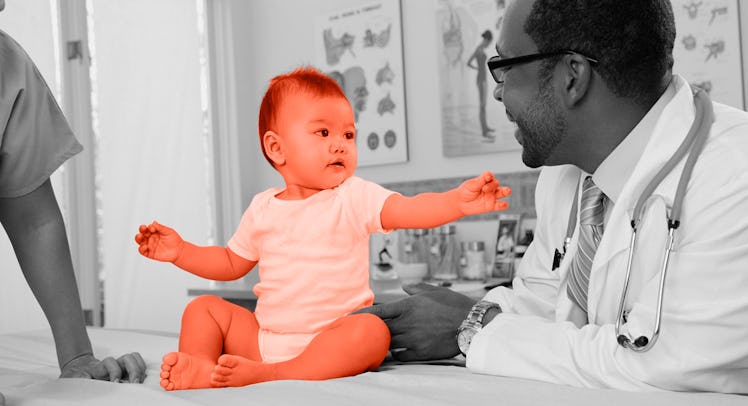How to Get Your Baby Tested for Allergies
Allergy testing for babies may seems scary, but not it's not as scary – or as awful – as anaphylaxis.

Testing for baby allergies can be an ordeal. It’s hard to watch your kid go through a blood or skin allergy test, and costs can be prohibitive if insurance won’t cover it. That said, allergies are no joke, and food allergies in babies and toddlers can be fatal. So if a kid starts showing symptoms of an allergic reaction, parents should speak to their pediatrician immediately about allergy testing.
“For a baby, the first sign might be eczema,” says Sonal Patel, M.D., double-board certified in allergy and clinical immunology as well as pediatrics, and author of The Mommy MD Guide to Twins, Triplets. and More. “When solids are started, you may notice an immediate reaction with redness, swelling, or difficulty breathing after introducing a new food. Other signs can include asthma or wheezing. Older children may see hay-fever-like symptoms with chronic congestion, rhinorrhea, and sneezing, as well.”
A severe rash or respiratory distress warrants emergency intervention, but even a mild reaction in infants and toddlers should be reported to the pediatrician, since future reactions may well be more severe.
Allergy Testing for Kids
- Allergy testing – both food and environmental allergies can be tested by skin tests and blood tests. Skin tests require a series of small scratches or pricks to be made in the skin, whereas blood tests require blood to be drawn.
- Testing shows food allergies, not intolerances – food testing identifies an IgE mediated sensitivity, meaning exposure might send those patients into anaphylaxis. It does not test for food intolerances or sensitivities.
- Allergy testing cost – allergy testing is usually covered by insurance. Cost may vary depending on where the doctor is and the insurance they accept, as well as on how many allergens are being tested for.
For previous generations of allergy sufferers, allergy testing involved a skin prick test. Contemporary doctors now prefer ImmunoCAP allergy blood tests over skin prick tests, at least for babies. It’s not necessarily because the ImmunoCAP is less invasive – blood is still being drawn. The reason is much more practical.
“Babies have a smaller surface area, so you really can’t test for too many allergens,” Dr. Patel explains. “Some babies need a routine blood test for their one-year physical to check for anemia – it may be a good time to add the allergy test, so the baby doesn’t have to be poked an extra time.”
An allergist may still opt for the skin prick test; neither the blood draw nor the skin prick allergy test is as painful as being vaccinated, says Dr. Patel. But they are certainly uncomfortable ordeals that can be frightening to a child.
“Parents should expect that their children will be scared,” cautions Dr. Patel. “Of course, with a blood draw, there is pain associated. The skin testing, in my opinion, is less painful than a blood draw, especially if using the multi-test. But it still is uncomfortable and scary for the patient, so most children do cry.”
Barriers aside, parents shouldn’t hesitate to have their child tested for allergies – even if an undiagnosed allergic reaction isn’t severe enough to endanger a baby’s life, it sure is enough to make them irritable and fussy. After all, they don’t have many ways to communicate that they don’t feel well. So it may very well be worth trading off an uncomfortable appointment at the allergist for a calmer, happier baby at home.